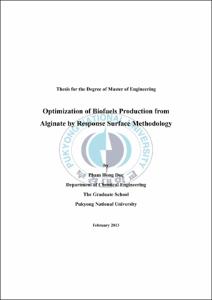Optimization of Biofuels Production from Alginate by Response Surface Methodology
- Abstract
- This study was conducted to evaluate the optimum anaerobic fermentative conditions of alginate with the respect to the simultaneous effects of sodium alginate concentration and pH to maximize volatile fatty acids and ethanol productions. The optimization was based on central composite design (CCD) and performed by response surface methodology (RSM) on Minitab software (version 15.1.1.0., Minitab Incorporation, USA).
Sodium alginate using as sole carbon source was obtained from Wako company. Anaerobic sludge from local municipal wastewater treatment plant was acidic pretreated by HCl 2N for 24 hours at 35⁰C in order to enhance volatile fatty acids (VFAs) and ethanol production. A series of anaerobic fermentative processes was carried out in amber reactors at 35⁰C and 120 rpm.
Total volatile fatty acids (TVFAs) production in alkaline condition was more efficiency than that of acidic condition. According to response surface analysis (RSA), optimum conditions for maximum TVFAs yield were sodium alginate 9.0 g/L and pH 7.8. The maximum response value was estimated approximately 4.3 g/L. The VFAs produced from the system consisted of acetic, propionic, and butyric acids. Among them, acetic acid was the major component. In addition, H2 and CO2 was produced biogas in the system, whereas CH4 (methanogenesis) was inhibited in order to improve biofuels production during acidogenesis. H2 yield in acidic and alkaline condition was 1.66% and 4.03%, respectively.
- Issued Date
- 2013
- Awarded Date
- 2013. 2
- Type
- Dissertation
- Publisher
- 부경대학교
- Affiliation
- 부경대학교 대학원
- Department
- 대학원 화학공학과
- Advisor
- 우희철
- Table Of Contents
- CONTENTS i
LIST OF TABLES iii
LIST OF FIGURES iv
NOMENCLATURE vi
ABSTRACT viii
1. INTRODUCTION 1
1.1. General backgrounds 1
1.2. Research objectives 2
2. LITERATURE SURVEY 3
2.1. Brown algae 3
2.2. Alginate 6
2.3. Biofuels production 12
2.3.1. Dark fermentation 12
2.3.2. Generations of biofuels 14
2.3.3. Volatile fatty acids 16
2.3.4. Biogas production 19
2.4. Mathematical model building 21
2.4.1. Response surface methodology 21
2.4.2. Experimental design 24
3. MATERIALS AND METHODS 26
3.1. Inoculum system 26
3.2. Experimental design 26
3.3. Experimental procedure 29
3.4. Analytical methods 32
4. RESULTS AND DISCUSSION 35
4.1. Estimating maximum condition of VFAs and ethanol production (Exp. I and Exp. II) 35
4.2. Estimating optimum condition of VFAs and ethanol production (Exp. III) 37
4.3. Biofuels production from different type of alginates 43
4.4. Biogas production and hydrogen yield 46
5. CONCLUSIONS 50
REFERENCES 51
APPENDIX 54
ACKNOWLEDGEMENTS 58
- Degree
- Master
- Files in This Item:
-
-
Download
 Optimization of Biofuels Production from Alginate by Response Surface Methodology.pdf
기타 데이터 / 2.79 MB / Adobe PDF
Optimization of Biofuels Production from Alginate by Response Surface Methodology.pdf
기타 데이터 / 2.79 MB / Adobe PDF
-
Items in Repository are protected by copyright, with all rights reserved, unless otherwise indicated.